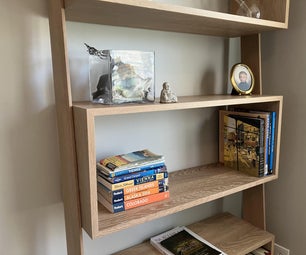Introduction: Sun Lounging Wedge With Adjustable Back
With summer on the horizon, and most of us spending a lot of time at home right now, I wanted to design a lounger with an adjustable back that would allow me to enjoy the sun or read a book out on my deck. I wanted something compact that I could easily store away when not in use. That’s how I came up with this deck wedge that folds flat for easy storage, and you can pretty much set it down anywhere you want.
Supplies
MATERIALS USED
- Cedar wood https://amzn.to/3avzYNi
- Wood dowel https://amzn.to/2SmqVYJ
- Pocket screws https://amzn.to/3cHy4dU
- Carriage bolts https://amzn.to/355ci1d
- Nylon lock nuts https://amzn.to/3azrRzg
- Teak oil https://amzn.to/36t1Uk0
TOOLS USED
- Belt/Spindle Sander https://amzn.to/2uVsW54
- Router table build http://bit.ly/RouterTableSeries
- Router bit (roundover) https://amzn.to/2MDcYBG
- Countersink bit set https://amzn.to/3aOE2JE
- Forstner bits https://amzn.to/2Rht87h
- Center line scriber https://amzn.to/2VFaN70
Step 1: Watch the Video / Get the Plans
Step 2: Cut / Prep Parts
With the COVID-19 lockdown still in full force, I turned to my lumber rack to see what materials I had on hand and what I could potentially build out of them. I set my sights on some leftover cedar that was donated to me by a friend, because of course, I’ve become that person that everyone offloads their wood scraps on. And, well, I willfully accept them.
I started by squaring up the end of each board, then set my stop block so I could batch out evenly sized pieces. I went back and forth between the table saw and miter saw until all my pieces were cut to size, ultimately ending up with 6 long thin pieces and 10 wider short pieces.
I used my homemade router table with a roundover bit to smooth all the edges and give the boards a more professional look.
Step 3: Create Round Board Ends
I found a circular object the same width as my board and used it to trace out a semi circle on one end of each thin long board. I then took it over to my belt sander and slowly sanded away the corners, progressively sculpting until I reached the line and was left with a rounded edge, and this repeated for all 6 long thin pieces.
Step 4: Hooked Slats for Adjustable Back
Next I need to make hooked slats for the adjustable back. I started by making evenly spaced markings and then transferred those over to the second piece. I then measured half an inch inwards and used an awl to punch a pilot hole. I could then use a Forstner bit to drill the 4 holes all the way through.
To shape the slots the way I want them, I used a square on one side to make a perpendicular line and used the 45 degree edge of my square to make a line on the other side.
If I had a bandsaw I might have used it to make these cuts, but I used a shortcut and decided I could just shape the slots using my sander with a spindle attachment. Just as before, I slowly sanded away, progressively shaping the wood until I reached the lines and I was left with the 4 sculpted hooks.
Step 5: Back Slat Supports
To make the pieces that will support the back slats, I first marked a line down the center of the back of the slat, then measured and marked evenly spaced reference marks. I used the drill press so I could control the depth, and used a Forster bit to countersink the holes that will be used for the screws.
After that, I could use a regular bit to drill all the way through, using a bit large enough to allow the screw to pass through.
Step 6: Adjustable Swing Arm
The third piece of the mechanism is the swing arm that allows the back to be adjusted. I’m going to use a large dowel to connect both arms. I used a Forstner bit to make a countersink hole the same size as my dowel, making sure not to go all the way through. I did a dry fit to check that everything was good and then used some glue to assemble the parts.
Step 7: Assembly Prep
The idea is that the back will be able to incline, so I need to make holes so I can assemble the mechanism using some bolts. I clamped both pieces together to make sure that the holes in both pieces will be perfectly aligned and used the drill press to drill all the way through.
Before assembly, I sanded all the individual parts used 120-grit. After cleaning away all the sawdust, I pre-finished all the parts with teak oil. I simply used a clean cloth to rub in the finish and let it dry overnight.
Step 8: Assembly
For assembly, I used carriage bolts and nylon lock nuts. With my parts laid out, with the hooked pieces on the inside, I simply slipped in the bolts and then added lock nuts that I tightened all the way.
To attach the back slats, I clamped some stops to the edge of my workbench, and flipped the mechanism onto the slats, then push it to the very top edge. I could then use a leftover piece as a spacer and push everything up and in, and screw the first slat on. I repeated the same process on the opposite side, and could then use some spacer blocks to position the second slat, and screw it into place. I kept going like this, slat by slat, pushing everything into alignment and screwing on the slats, until I reached the end.
If you haven't already, watch the video for details on the build, and if you like what you see, subscribe to my YouTube channel.
I have build plans available for purchase if you want to check those out here.
__________________________
More from DIY Montreal:











